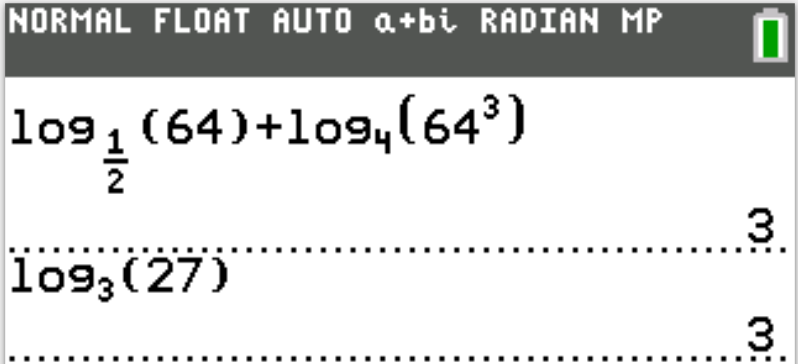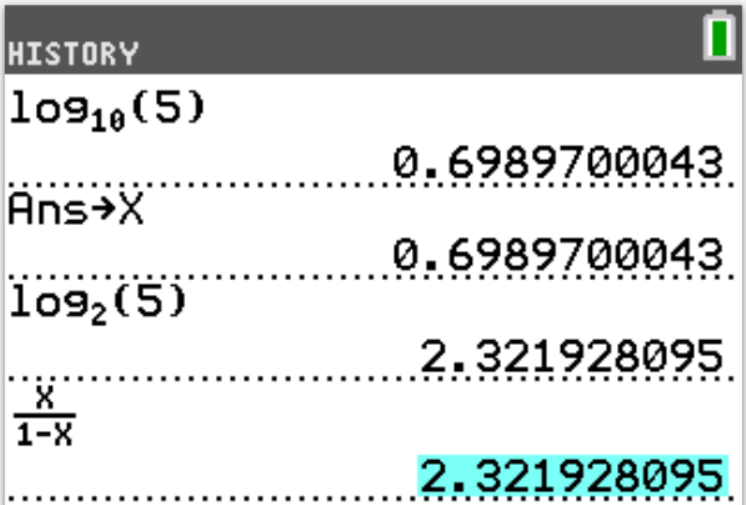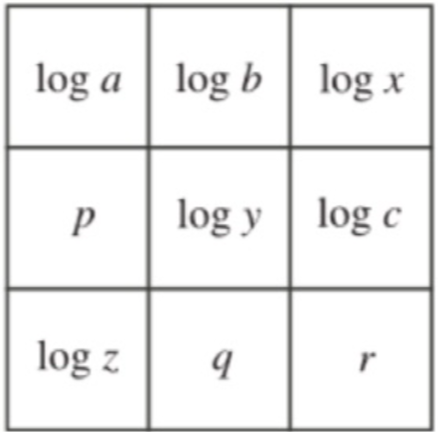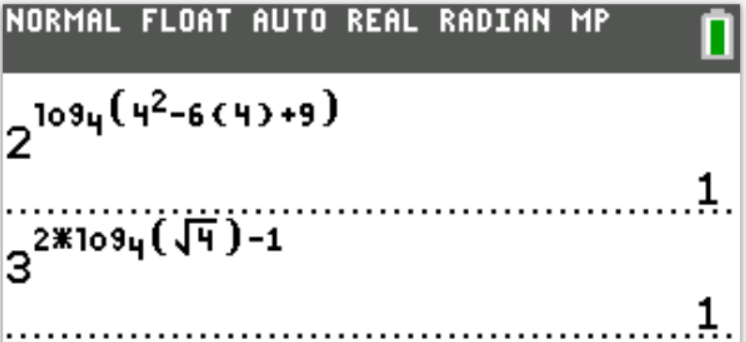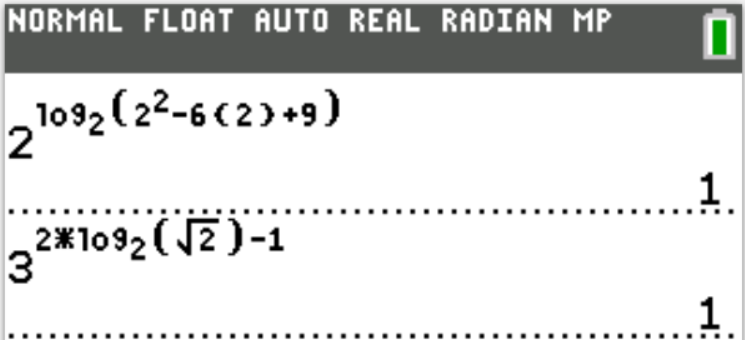Exponents and Logarithms
Welcome to Our Site
I greet you this day,
These are the solutions to Mathematics questions on the topics: Exponents and Logarithms.
When applicable, the TI-84 Plus CE calculator (also applicable to TI-84 Plus calculator) solutions are provided
for some questions.
If you find these resources valuable and helpful in your learning, please
consider making a donation:
Cash App: $ExamsSuccess or
cash.app/ExamsSuccess
PayPal: @ExamsSuccess or
PayPal.me/ExamsSuccess
Google charges me for the hosting of this website and my other
educational websites. It does not host any of the websites for free.
Besides, I spend a lot of time to type the questions and the solutions well.
As you probably know, I provide clear explanations on the solutions.
Your donation is appreciated.
Comments, ideas, areas of improvement, questions, and constructive
criticisms are welcome.
Feel free to contact me. Please be positive in your message.
I wish you the best.
Thank you.
Factoring Formulas
$ \underline{Difference\;\;of\;\;Two\;\;Squares} \\[3ex] (1.)\;\;x^2 - y^2 = (x + y)(x - y) \\[5ex] \underline{Difference\;\;of\;\;Two\;\;Cubes} \\[3ex] (2.)\;\; x^3 - y^3 = (x - y)(x^2 + xy + y^2) \\[5ex] \underline{Sum\;\;of\;\;Two\;\;Cubes} \\[3ex] (3.)\;\; x^3 + y^3 = (x + y)(x^2 - xy + y^2) $Laws of Exponents and Laws of Logarithms (Math)
-
Law 1: Exponents
-
(1.) Product Rule
$ p^c * p^d = p^{c + d} \\[4ex] p^{c + d} = p^c * p^d $
-
Law 1: Logarithms
-
(1.)
$ \log_p{c} + \log_p{d} = \log_p{cd} \\[4ex] \log_p{cd} = \log_p{c} + \log_p{d} $
-
Law 2: Exponents
-
(2.) Quotient Rule
$ p^c \div p^d = p^{c - d} \\[4ex] \dfrac{p^c}{p^d} = p^{c - d} \\[4ex] p^{c - d} = p^c \div p^d \\[4ex] p^{c - d} = \dfrac{p^c}{p^d} $
-
Law 2: Logarithms
-
(2.)
$ \log_p{c} - \log_p{d} = \log_p({c \div d}) \\[4ex] \log_p{c} - \log_p{d} = \log_p{\left(\dfrac{c}{d}\right)} \\[5ex] \log_p({c \div d}) = \log_p{c} - \log_p{d} \\[4ex] \log_p{\left(\dfrac{c}{d}\right)} = \log_p{c} - \log_p{d} $
-
Law 3: Exponents
-
(3.)
$ {any\: base}^0 = 1 \\[5ex] p^0 = 1 $
-
Law 3: Logarithms
-
(3.)
$ \log_{any\: base}{1} = 0 \\[5ex] \log_p{1} = 0 \\[4ex] \ln{1} = \log_e{1} = 0 $
-
Law 4: Exponents
-
(4.)
$ {any\: base}^1 = any\: base \\[5ex] p^1 = p $
-
Law 4: Logarithms
-
(4.)
$ \log_{any\: base}{any\: base} = 1 \\[5ex] \log_p{p} = 1 $
-
Law 5: Exponents
-
(5.) Expanded Power Rule
$ (p)^c = (p^1)^c = p^{1 * c} = p^c \\[5ex] \left(\dfrac{p}{q}\right)^c = \dfrac{p^c}{q^c} \\[7ex] (p^c)^d = p^{c * d} \\[5ex] p^{c * d} = (p^c)^d \\[7ex] \left(\dfrac{p^c}{q^d}\right)^e = \dfrac{p^{ce}}{q^{de}} \\[7ex] (pk)^d = p^d * k^d \\[5ex] p^d * k^d = (pk)^d \\[5ex] (p^c k^d)^m = p^{cm} * k^{dm} \\[5ex] p^{cm} * k^{dm} = (p^c)^m * (k^d)^m = (p^c k^d)^m \\[5ex] (p^c)^{\dfrac{d}{e}} = p^{\dfrac{cd}{e}} \\[7ex] p^{\dfrac{cd}{e}} = (p^c)^{\dfrac{d}{e}} $
-
Law 5: Logarithms
-
(5.)
$ \log_p{c^d} = d * \log_p{c} \\[4ex] d * \log_p{c} = \log_p{c^d} $
-
Law 6: Exponents
-
(6.) Rule of Negative Exponents
$ p^{-c} = \dfrac{1}{p^c} \\[5ex] \dfrac{1}{p^c} = p^{-c} \\[5ex] p^c = \dfrac{1}{p^{-c}} \\[5ex] \dfrac{1}{p^{-c}} = p^c \\[5ex] p^{-\dfrac{c}{d}} = \dfrac{1}{p^{\dfrac{c}{d}}} \\[7ex] \dfrac{1}{p^{\dfrac{c}{d}}} = p^{-\dfrac{c}{d}} \\[7ex] p^{\dfrac{c}{d}} = \dfrac{1}{p^{-\dfrac{c}{d}}} \\[7ex] \dfrac{1}{p^{-\dfrac{c}{d}}} = p^{\dfrac{c}{d}} $
-
Law 6: Logarithms
-
(6.)
Change of Base of Log
$ \log_p{d} = \dfrac{\log_c{d}}{\log_c{p}} \\[4ex] \dfrac{\log_c{d}}{\log_c{p}} = \log_p{d} \\[4ex] \log_p{d} * \log_c{p} = \log_c{d} \\[4ex] \log_c{d} = \log_p{d} * \log_c{p} $
-
Law 7: Exponents
-
(7.) Rule of Fractional Exponents
$ p^{\dfrac{1}{c}} = \sqrt[c]{p} \\[5ex] p^{\dfrac{c}{d}} = \sqrt[d]{p^c} \\[5ex] p^{\dfrac{c}{d}} = (\sqrt[d]{p})^c \\[5ex] \sqrt[d]{p^c} = p^{\dfrac{c}{d}} \\[5ex] (\sqrt[d]{p})^c = p^{\dfrac{c}{d}} $
-
Law 7: Logarithms
-
(7.)
$ p^{\log_p{c}} = c \\[5ex] c = p^{\log_p{c}} \\[5ex] p^{d\log_p{c}} = p^{\log_p{c^d}} = c^d \\[5ex] c^d = p^{\log_p{c^d}} = p^{d\log_p{c}} \\[5ex] e^{\ln{c}} = c \\[5ex] c = e^{\ln{c}} \\[5ex] e^{d\ln{c}} = e^{\ln{c^d}} = c^d \\[5ex] c^d = e^{\ln{c^d}} = e^{d\ln{c}} $
Laws of Exponents
Law 1:
If two or more expressions have: the same base, and are being multiplied;
Keep the base
Add the exponents.
Law 2:
If two expressions have: the same base, and are being divided;
Keep the base
Subtract the exponents.
Subtracting the exponents means subtract the exponent of the denominator from the exponent of the
numerator.
Law 3:
Any base raised to an exponent of $0$ gives a result of $1$
In other words, the result of any base raised to an exponent of 0, is 1
Law 4:
Any base raised to an exponent of $1$ is that base.
In other words, the result of any base raised to an exponent of 1, is that base.
Law 5:
If an expression, having one base enclosed in parenthesis, has two exponents: an inner exponent
and an outer exponent;
Keep the base
Multiply the exponents.
If an expression, having a product of multiple bases enclosed in parenthesis, has two exponents:
an inner exponent and an outer exponent;
Keep each base as a product
Multiply the exponents.
Law 6:
A base with a negative exponent is the reciprocal of the same base with the corresponding positive exponent.
A base with a positive exponent is the reciprocal of the same base with the corresponding negative exponent.
Law 7:
Fractional exponents leads to radicals.
In other words, a base whose exponent is a fraction can be expressed as a radical.
Laws of Logarithms
Law 1:
If two logarithms have: the same base, and are being added;
Keep the base
Multiply the numbers.
Law 2:
If two logarithms have: the same base, and are being subtracted;
Keep the base
Divide the numbers.
Law 3:
The logarithm of the number, 1; to any base gives a result of 0
In other words, the result of the logarithm of 1; to any base is 0
Law 4:
The logarithm of a number; to that number as the base, gives a result of 1
In other words, the result of the logarithm of a number to that same number as the base is 1
Law 5:
The logarithm of a number to a base, raised to an exponent; is equal to the exponent times the logarithm of that
number
to the base.
Law 6:
This Law deals with the Change of Base of Logarithms.
Any logarithm of a number to a base, can be expressed as a ratio of two logarithms to another base.
Say you have the logarithm of a number say $d$ to a base, say p; and
You want to change the base of that logarithm to another base, say c; then the
logarithm of d to base p is the logarithm of d to base c divided by the logarithm of
p to base c.
In other words, the logarithm of d to base p is the ratio of the logarithm of d to base
c, to the logarithm of
p to base c.
Law 7:
This Law actually deals with both exponents and logarithms.
The result of a base, raised to an exponent of the logarithm of a number whose base is the base, is the number.
